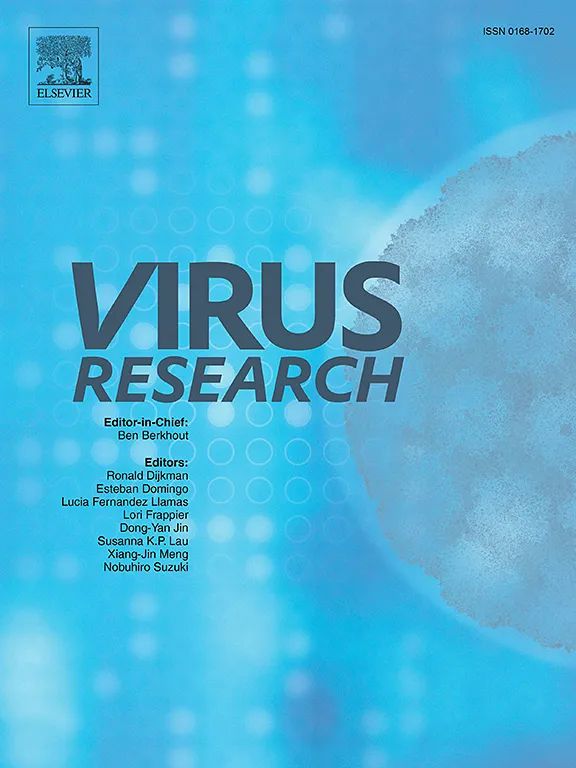雉鸡(Phasianus colchicus)中禽传染性支气管炎病毒的复制和适应。
IF 2.7
4区 医学
Q3 VIROLOGY
引用次数: 0
摘要
传染性支气管炎病毒(IBV)不仅导致全球数百万只鸡患病,而且还从其他家禽中发现或分离出类似 IBV 的病毒。我们认为野鸡冠状病毒(PhCoV)源自 IBV。事实上,IBV 毒株 H120 和 M41 可以在雉鸡体内复制,但不会导致疾病。本研究发现,ck/CH/LDL/091021、ck/CH/LDL/140520和I0305/19等3株鸡肾致病性IBV毒株,以及从受到各IBV毒株挑战的雉鸡组织中回收的病毒,可在一些受到挑战的雉鸡体内复制,复制能力不同,但不会致病。总体而言,这些病毒在雉鸡体内的复制和适应能力不同,在不同数量的雉鸡体内均可检测到针对各IBV株的中和抗体,但滴度普遍较低,且差异较大。相对而言,ck/CH/LDL/140520 和 20/P1-D5/Tr1 对雉鸡的适应能力较强。此外,三种 IBV 株系在雉鸡体内传代一次后,其适应能力均有所提高,尤其是 ck/CH/LDL/140520 株系,在雉鸡体内传代后,其适应能力提高,组织滋养能力增强。与鸡的 IBV 相似,病毒在雉鸡体内复制和传代时,病毒内部的亚群被选择出来,每个病毒亚群基因组中突变和缺失的积累是病毒在雉鸡不同组织中独立进化的原因。综上所述,我们认为phCoVs可能起源于IBV,通过种间传播从鸡传给雉鸡,然后在种内传播过程中在雉鸡体内获得更强的组织滋养、适应能力和致病行为。本文章由计算机程序翻译,如有差异,请以英文原文为准。
Replication and adaptation of avian infectious bronchitis viruses in pheasants (Phasianus colchicus)
Infectious bronchitis virus (IBV) does not only cause disease in millions of chickens worldwide, but IBV-like viruses have also been detected or isolated from other domestic birds. We propose that the pheasant coronavirus (PhCoV) originates from IBV. Indeed, the IBV strains H120 and M41 can replicate but do not cause disease in pheasants. In this study, we found that three chicken nephropathogenic IBV strains, including ck/CH/LDL/091,021, ck/CH/LDL/140,520, and I0305/19, and the viruses recovered from the tissues of pheasants challenged with each IBV strain could replicate in some challenged pheasants with different capacities but could not cause disease. Overall, these viruses showed different capacities of replication and adaptation in pheasants, and the neutralizing antibody against each IBV strain could be detected in different numbers of pheasants challenged with each of the viruses, although the titers were generally low with large variation. Comparatively, ck/CH/LDL/140,520 and 20/P1-D5/Tr1 showed higher adaptation capacities in pheasants. Furthermore, the three IBV strains gained an increased capacity for adaptation when they passed in pheasants once, especially strain ck/CH/LDL/140,520, which gained an increased capacity for adaptation and extended tissue tropism when it was passaged in pheasants. Similar to IBV in chicken, the subpopulations within the virus were selected when the virus replicated and was passaged in pheasants, and the accumulation of mutations and deletions in the genome of each virus subpopulation accounted for the independent evolution of the virus in different tissues of pheasants. Taken together, we suggest that the phCoVs might originate from IBV through interspecies transmission from chickens to pheasants, before gaining increased tissue tropism, adaptation capacities, and disease-causing behaviors in pheasants during intraspecies transmission.
求助全文
通过发布文献求助,成功后即可免费获取论文全文。
去求助
来源期刊

Virus research
医学-病毒学
CiteScore
9.50
自引率
2.00%
发文量
239
审稿时长
43 days
期刊介绍:
Virus Research provides a means of fast publication for original papers on fundamental research in virology. Contributions on new developments concerning virus structure, replication, pathogenesis and evolution are encouraged. These include reports describing virus morphology, the function and antigenic analysis of virus structural components, virus genome structure and expression, analysis on virus replication processes, virus evolution in connection with antiviral interventions, effects of viruses on their host cells, particularly on the immune system, and the pathogenesis of virus infections, including oncogene activation and transduction.
 求助内容:
求助内容: 应助结果提醒方式:
应助结果提醒方式:


